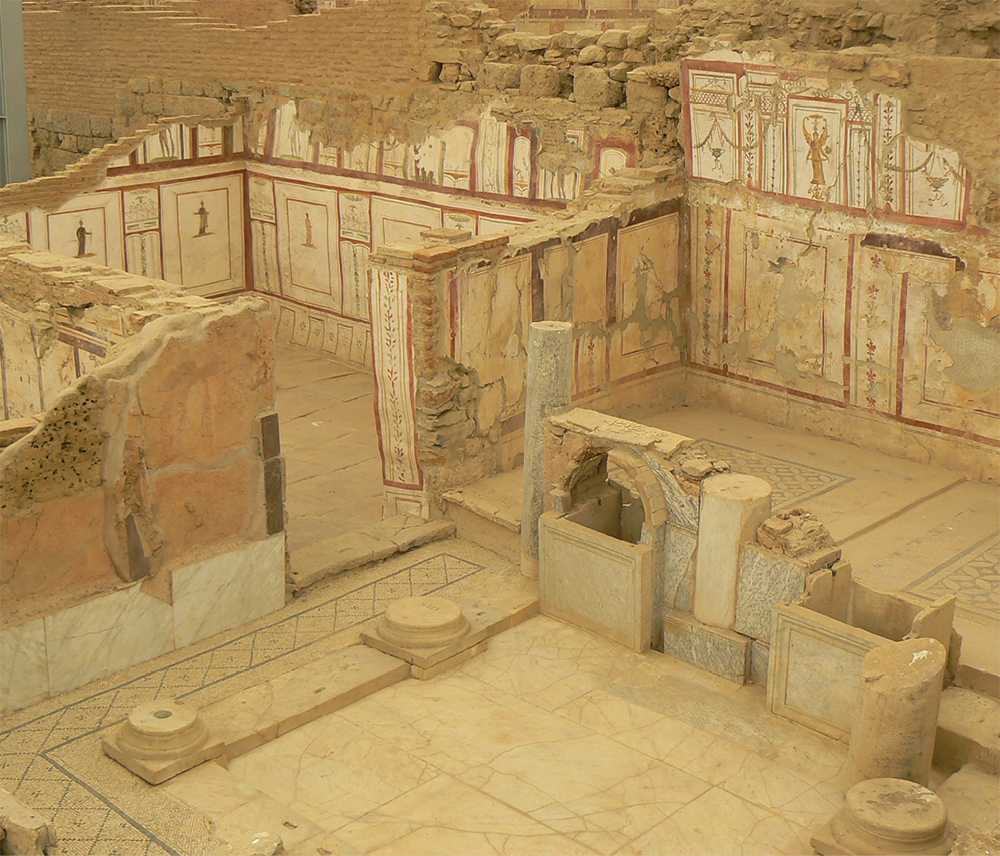Introduction to 2 John
Share
This resource is exclusive for PLUS Members
Upgrade now and receive:
- Ad-Free Experience: Enjoy uninterrupted access.
- Exclusive Commentaries: Dive deeper with in-depth insights.
- Advanced Study Tools: Powerful search and comparison features.
- Premium Guides & Articles: Unlock for a more comprehensive study.
INTRODUCTION TO
2 JOHN
The second epistle of John advises “the elect lady” (either a reference to a congregation or to a woman who owned a house where the congregation met) to be fervent in Christian love (v. 5) and watchful of deceivers (vv. 7-8). The writer planned to visit the congregation soon (v. 12).

Terrace houses in Ephesus, dating to 100 BC. These structures were discovered around 1960 and are still in the process of restoration. They provide a glimpse into the lifestyle of the wealthy. These structures were two stories with a courtyard, living rooms and dining rooms on the ground floor, and bedrooms upstairs. These houses were heated in the winter and had both hot and cold running water.
CIRCUMSTANCES OF WRITING
AUTHOR: “The elder” (v. 1) is a title that the apostle John applied to himself late in life. (The apostle Peter referred to himself the same way; 1Pt 5:1.) No one other than the apostle John was ever suggested by the early church as the writer of 1 John. Since there are so many similarities between 1 and 2 John, it is generally accepted that John also wrote the second letter.
BACKGROUND: Second John likely was written during the last two decades of the first century. During this era, John gave pastoral leadership to churches in the area of Ephesus. We have no way of precisely dating 2 John, but it is reasonable that it was written around the same time as 1 John or slightly afterwards. Its tone reveals it to be a highly personal letter that reflects John’s affection for these believers and his deep concern for their welfare.
MESSAGE AND PURPOSE
Like Jesus, who wept over Jerusalem (Lk 19:41), and Paul, who wrote of “the daily pressure” of his “concern for all the churches” (2Co 11:28), John was concerned about this congregation. Would they neglect to embody God’s love for one another? Would they fall prey to false teachers? Second John was apparently written to help readers follow through on their commitment to follow Christ.
John used six key words to tie together this epistle. He repeatedly used the words trust (five times), love (four times), commandment (four times), walk (three times), teaching (three times), and children (three times). John’s message is clear: He told his children to: (1) walk in the truth, (2) obey God’s commandments, (3) love one another, and (4) guard the teachings of Christ and they would not be deceived by the antichrist. John confirmed the spiritual safety of the believing community with a beginning and ending reference to their election by God (vv. 1,13).
CONTRIBUTION TO THE BIBLE
It is easy for congregations to get off track. Second John reminds readers of the high priority of the most basic Christian outlook and activity—mutual love. Yet another priority is no less critical—true Christian teaching. This epistle strikes a short but strong blow for steadfastness, assuring that attentive readers would take the right steps to “receive a full reward” (v. 8).
STRUCTURE
Second John is an excellent example of hortatory or exhortation discourse, which has the intent of moving readers to action. It follows the normal NT pattern for a letter with an opening, main body, and closing. There are only two commands in this short letter: a call to “watch yourselves” (v. 8) and the command, “do not receive” those who plant false teaching (v. 10). There is the reminder to “love one another” in v. 5. This bears the force of an imperative, in part because of the close proximity of the word “command,” which occurs four times in vv. 4-6.
OUTLINE
I.Greeting and Blessing (vv. 1-3)
II.Exhortation to Christian Love (vv. 4-6)
III.Warnings about False Teachers (vv. 7-11)
IV.Impending Visit and Blessing (vv. 12-13)
AD 17-61
Ephesus experiences a destructive earthquake. 17
Paul travels through Ephesus toward the end of his second missionary journey. 52
Apollos comes to Ephesus and is mentored by Aquila and Priscilla. 52
Paul returns to Ephesus for a 21/2 year ministry. 54
Paul writes the letter to the Ephesians. 61
AD 62-67
Timothy, elder of Ephesus, receives first letter from Paul, 1 Timothy. 62
Peter’s first letter from Rome to Christians in Pontus, Galatia, Cappadocia, Asia, and Bithynia 64
Peter’s second letter from Rome 66
The Jewish War is started by zealots who drive the Romans out of Jerusalem temporarily. 66
Timothy receives second letter from Paul, 2 Timothy. 67?
AD 67-70s
Peter and Paul’s death in Rome 64-67?
John leaves Jerusalem for Ephesus. 66-70?
The Romans crush the Jewish rebellion and destroy Jerusalem and the temple. 70
John is spiritual leader of the church at Ephesus. 70-100
John’s Gospel written 70s
AD 80s-100
John’s first letter (1 John) to the churches of Asia Minor 80s
John’s letter to the elect lady (2 John) 80s
John’s letter to Gaius (3 John) 80s
John is exiled to Patmos and writes the book of Revelation. 95
Ephesus becomes one of the largest cities in the Roman province of Asia after Sardis and Alexandria Troas. 100